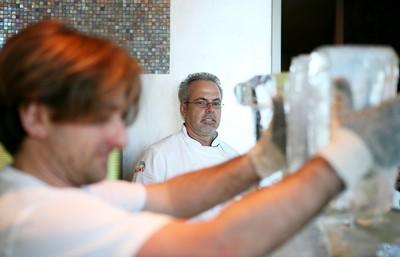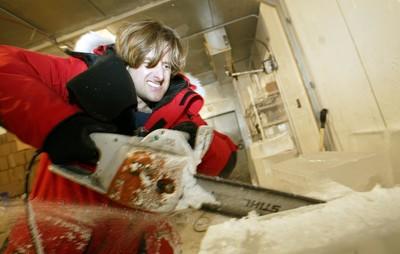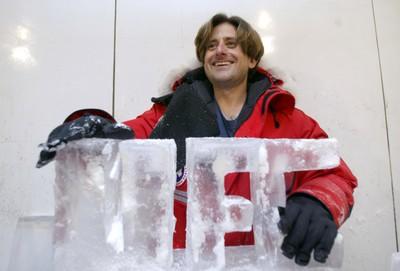NEW KID ON THE ICE BLOCK (Ice sculptor)
I can't tell which is more icy -- my latest creation or the reaction to it. The customer who ordered the Ultimate Fighting Championship ice sculpture for her party at the Palms is not satisfied.
"Oh no, no," she says.
What? The letters are readable.
The woman, who asked not to be identified, ordered the official company logo from Ice Occasions, not block letters spelling out "UFC" in a font approximating Alpha-Bits.
This is quite possibly the most awkward moment in ice sculpture since that lady in "My Best Friend's Wedding" got her tongue stuck on the naughty bits of Michelangelo's David.
Palms executive chef Henry Garcia winces as though I just unwrapped the frozen head of Walt Disney.
"You should have gotten beaten up for that," he tells me later. (And he didn't even see the "C" they made me throw out.)
Ice Occasions is one of the largest of 500 ice-sculpting companies in the United States. It earns $1.5 million a year transforming 40-inch-by-20-inch-by-10-inch blocks of frozen water into insignias, shapes -- pretty much anything.
"One guy, for his birthday party, wanted a male fornicating with a female in the doggy position," says company co-owner Denny Wold, 43, who complied.
"We can do anything," he says, "as long as it's stable and won't topple over."
Wold and his business partner, Ryan McDougall, began carving ice in their native Canada, where it is a particularly popular form for water to be found.
"We came to Las Vegas because it's one of the best, if not the best, market in the country," he says. "It's the No. 1 convention city, and the Strip is close to everything."
Ice Occasions starts its sculpting on computer. A design is created on graphics software, then fed into a $50,000 Computer Numerical Controlled machine (the company has two), which etches it into the ice from behind (so the surface remains smooth). Then chain saws and grinders are used to cut and perfect the shape.
The process takes about a day from start to finish -- not including the four days it takes for each block to freeze solid. Today's project may take longer.
"We're not gonna give you computers," says Wold. "I want you to do the hands-on version. You're gonna have to work for your doughnuts today, buddy. This is how we all started."
He hands me a chain saw. I inquire as to what cleanser gets blood stains out of ice.
"Spit," he says.
Wold knows. Seven years ago, while cutting divets into a frozen golf ball with a Makita dye-grinder spinning at 25,000 rpm, he cut one into his finger, too. It required 33 stitches.
"I wasn't paying attention and I got it too close and it grabbed my glove," he says. "You only do something like that once."
The golf ball sculpture was still delivered, by the way.
VEEEERM!
By the way, the sound of a chain saw and an expectation of basic competence from me are not things that should ever mix. Wold is directing me to follow the lines he has drawn in marker on the ice.
"Start with shallow cuts, then go deeper," he says from a wisely safe distance.
A chain saw through ice feels like a plastic knife through week-old French bread. Then again, I can't vouch for the validity of any sensation being reported by my gloved fingers, since they're colder than the relationship between Donald Trump and Rosie O'Donnell.
The thermometer reads 9 degrees. Wold says it's broken, and it's more like 20 degrees.
"It's warm in here today," he says.
This brings me to the disadvantages of working in a city where the high temperatures exceed four times the melting point of your medium. Wold's electric bill is $5,000 a month in the summer (nearly twice what it costs in the winter).
And the temperature difference between indoors and out can't be good for you. My Palm Treo has stopped lighting up because of the condensation trapped inside, and the same thing feels like it's happening to my brain.
For an ice sculptor in Las Vegas, a cold day in hell is apparently a regular event.
"I love the cold," Wold says. "I can be in here for 10 hours without even coming out sometimes."
Ice sculptors work 40 to 60 hours a week, producing 100 to 120 sculptures a week -- as many as 500 on New Year's Eve. Although classes are given at many culinary schools, no specific training or certification is required.
"You get to be creative," Wold says. "It's fast-paced. You never get bored, and you're always doing something cool."
The pay is $50,000 a year to start.
"But we might have to start you off a little lower," Wold says.
I'm done with my sculpture. I am able to surmise this because of the wood I hit on the base I'm cutting on.
"That's not what we ordered," says the woman back at the Palms.
Ice sculptures range in price from $300 to $30,000 (for a 30-foot-high logo). The charge for my UFC disaster-piece will be $360.
I'm not Ashton Kutcher. I don't have the heart to put the woman through more than 12 seconds of watching her career flash before her eyes. The real sculpture is here, too, I inform her, and it's a veritable frozen Rembrandt.
"You're gonna put it up there, right?" she asks. "Right now?"
Watch video of Levitan as an ice sculptor at www.reviewjournal.com/video/fearandloafing.html. Fear and Loafing runs Mondays in the Living section. Levitan's previous adventures are posted at fearandloafing.com.
COREY LEVITANFEAR AND LOAFING
Watch the video






















